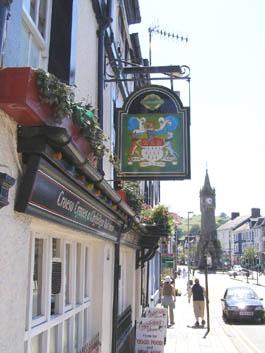Machynlleth (sometimes abbreviated to Mach) is a market town in the traditional county of Montgomeryshire (Sir Drefaldwyn), north Powys in Wales. It is in the Dyfi Valley, and is at the intersection of the A487 and the A489. It had a population of about 2,000 people according to the 2001 census.
It was the seat of Owain Glyndŵr's Welsh Parliament in 1404, and as such claims to be the "ancient capital of Wales." It applied for city status in the 2000 and 2002 competitions.
Machynlleth has a market day every Wednesday with a wide variety of stalls and sellers including gardening, fruit and veg, local food producers, music, crafts.
Machynlleth hosted the National Eisteddfod in 1937 and 1981.
History
From 1859 to 1948 it was served by the narrow-gauge Corris Railway, which brought slate from the quarries around Corris and Aberllefenni for onward despatch to the markets.
Machynlleth main-line station was built by the Newtown and Machynlleth Railway, and continues to provide a link to Aberystwyth and the Cambrian coast line to the west and Newtown and Shrewsbury to the east.
The daughter of local landowner Sir John Edwards married Viscount Seaham, the second son of the third Marquess of Londonderry, and they set up home in Plas Machynlleth. He became Earl Vane on the death of his father and the fifth Marquess on the death of his half-brother. To celebrate the 21st birthday of their son, Viscount Castlereagh, the townspeople subscribed to the erection (at the town's main road intersection) of the Clock Tower, which has become widely known as the symbol of Machynlleth. Another son, Lord Herbert Vane-Tempest, was the last member of the family to live at the Plas and was killed in the Abermule train collision on the Cambrian Railways, of which he was a director. The house was given to the townspeople after World War II. In recent years it was converted into the Celtica visitor centre.
Tourism
From 1995 until 2006, Celtica showcased Celtic life using audio-visual displays and exhibitions. Often hyped as having significant cultural importance, it always suffered from poor visitor numbers which ultimately forced its closure. Powys County Council are responsible for deciding what will become of the large mansion-style building gifted to the people of Machynlleth, but talk around town is that it will probably become a new set of council offices.
Even with the current closure of Celtica the primary employment sector remains tourism with a wide range of activity based attractions (for example several mountain bike trails) as well as visitor centres (Centre for Alternative Technology). Agriculture clearly continues to play a significant part in the make-up of the town and surrounding area as well. Another important local industry and employer is the renewable energy sector. The area now has a rapidly expanding renewable energy industry with several small to medium sized companies now operating in or around the town.
The town has a large market on Wednesdays which appeals to both locals and tourists. The Wales Museum of Modern Art, MOMA, presents lunchtime talks and performances on market days. |







